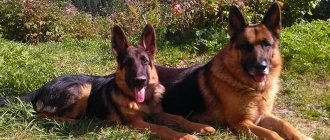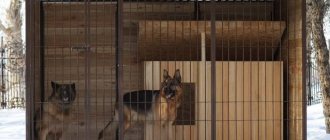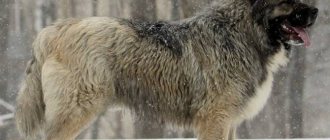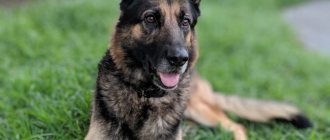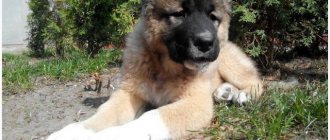Advantages of a booth for Caucasians
Placing the dog's permanent residence in a kennel in the yard has its advantages .
Firstly, the Caucasian Shepherd is a fairly large animal; in adulthood it reaches 60-65 cm at the withers and weighs about 70 kg. The apartment will be quite cramped for her, and the owners will not always be comfortable with such a neighborhood. Secondly, as a watchdog, this breed is more comfortable being outside, being able to observe the house and its surroundings. Thirdly, keeping a pet in a yard or in an enclosure allows you to maintain the required level of physical activity for a pet, which not every owner can provide when keeping an apartment.
How to build with your own hands?
Making a dog house yourself is easy and more cost-effective. The walls, floor and roof of the kennel are made double to reduce heat transfer. First, a frame is erected, and then it is covered on both sides: chipboard on the outside, and plywood on the inside. Mineral wool or polystyrene foam is placed between the layers.
It is preferable to make a pitched roof, since dogs love to climb up and watch the yard from a height. The roof covering must be non-slip to avoid injury. Most often, slate or ondulin is used. When laying a 2-pitch roof, a slope angle of 20–30 degrees is calculated. Tiles are used as a covering (video from the Sergeo Kirzhakoff channel).
Selecting a location
When building a doghouse for a shepherd, it is important to correctly determine its location.
The kennel should provide the widest possible view of the surrounding area. Remoteness from the habitat of other domestic animals that can serve as an external irritant. The distance from the house is at least 10 m, so as not to disturb the owners. It is important to consider the dominant wind direction. The open part of the enclosure and the hole into the booth should face the south, southwest or southeast direction. It is highly undesirable to make an exit to the north. There should be green space near the enclosure and dog kennel
They cast a thick shadow in which the animal takes refuge in the summer heat. The booth should not be placed directly on the ground to prevent moisture from penetrating inside. The structure is secured to supports or a low foundation.
Dimensions
Before you build a dog house with your own hands, you need to correctly determine its dimensions. A kennel that is too spacious does not heat up well, and the dog will freeze in winter. In an excessively cramped space, the dog will have nowhere to turn around. The entrance must correspond to the size of the animal.
If you plan to build a kennel for an adult, then the correct calculations are made taking into account the height and length of the animal.
- booth height = height + 10 cm (minimum 90 cm);
- width = height at withers (minimum 65 cm);
- depth = body length (minimum 115 cm);
- The parameters of the hole are calculated: the height is 5 cm below the dog’s height, and the width is 5-8 cm wider than its chest.
The total area of the enclosure is 6-8 square meters. If several individuals will live in the enclosure, then the main area must be increased by 1.5 times.
Tools and materials
To build a booth, you need to prepare the materials in advance:
- softwood boards;
- slats and bars;
- roofing materials - slate,
- soft tiles; insulation;
- plywood;
- nails.
The use of chain-link mesh in the construction of an enclosure is unacceptable. A shepherd can break it. Tools for assembly: hacksaw, hammer, drill, screwdriver, plane, tape measure.
Construction stages
The booth is built according to a simple drawing taking into account the specified parameters. Assembly takes place in several stages:
- The bottom gets knocked down: boards or an OSB sheet are nailed to 2 4*4 cm bars. On the other hand, vertical bars are attached at the corners and in the center of each side. At the site of the future entrance, 2 smaller bars are fixed.
- To protect against moisture, roofing material is fixed to the lower part of the bottom. Insulation is done in layers - glassine, insulation, glassine. The logs and floor are fixed on top.
- Wall cladding is carried out from the outside. To do this, boards 2–2.5 cm thick are laid. They are pre-impregnated with drying oil and painted. The walls are insulated from the inside and covered with plywood.
- The ceiling is made from plywood sheets. To do this, plywood is attached to a frame made of bars, and then insulation is created from polystyrene foam and plywood.
- The roof is constructed from timber gables, which are sheathed with boards on the outside and insulation on the inside. Roofing material is laid on top.
- The roof is connected to the base using corner pins (video author Ruslan Derkachuk).
Materials for building a booth
The best choice for the interior cladding of your pet's house is wood.
And cover the outside with insulation and waterproof coating, if the climate of your area requires it. The floor must be level, the boards must fit tightly to each other.
The roof can serve as an additional resting place for the dog in good weather, so it is preferable to make one slope, with a slight angle (15-20 degrees). A variety of roofing materials can be used to cover the roof, but metal sheathing is undesirable due to the noise it produces.
Adaptations for a dog's life
In addition to a place to sleep, the booth should also be an observation point for the watchman. Therefore, a canopy is often attached to it, under which the dog spends considerable time. should also be made under such a canopy to protect the occupant from dampness and dirt. You can also organize a feeding place there by placing bowls protected from rain and snow. You can install a chain hook into the wall or floor. Even if it is not intended to keep the dog on a chain, in some cases it may be necessary to secure it there.
Booth for Caucasian Shepherd (dimensions)
It is often difficult to choose a home for a dog from ready-made options, and owners decide to take matters into their own hands and make it themselves.
When drawing up drawings of a dog house, you should first of all take into account the size of the future inhabitant.
Inside, the dog should be able to stand and lie stretched out. This means that you need to find out the following sizes of the Caucasian Shepherd :
- the length of the interior, which will be equal to the length of the animal from nose to tail;
- width, which is equal to the height of the dog;
- height equal to the height of the dog.
To all of the above parameters you need to add 5 cm to ensure freedom of movement.
The entrance will be convenient if its width is equal to the width of the animal’s chest plus 5 cm, and its height is equal to its height minus five cm. Dimensions of a booth for a Caucasian Shepherd (drawing)
Attention! You should not make the booth too spacious - this will make it not more comfortable, but colder.
The location and size of the kennel for the Caucasian Shepherd on the site should be such that:
- the entrance was on the leeward side
- it was a good review
- moisture did not collect under it
- there was some distance (8-10 meters) from human habitation.
What does "Caucasian" mean?
Every now and then, on one of those giddy, formal police procedurals on TV, you'll hear a description of a suspect that seems straight out of the 1950s.
“Suspect is a 6-foot, 180-pound Caucasian, white T-shirt, jeans...”
Caucasian? Indeed? What does this even mean? What did it ever mean?
It is easy, of course, to equate “Caucasian” with “white.” “But this one word - Caucasian - touches on issues much deeper than skin color. It inflames questions of race and the very origins of people. It even explores the topic of whether race exists outside of our curious, sometimes devious minds.
Spoiler: In humans, there is no genetic basis for dividing our species into races. So if you are thinking about the "Caucasian race", think again.
What is a Caucasian?
“There is no scientific basis for using this term,” says Joseph Graves, professor of nanoengineering and interim dean of the Joint School of Nanoscience and Nanoengineering in Greensboro, North Carolina. “[Caucasian] is actually a 19th-century anthropological idea that was based on the false idea that the origin of the human species was in the Caucasus Mountains."
The Caucasus Mountains stretch from the Black Sea (in the west) to the Caspian Sea (in the east) in an area considered by many to be the crossroads between Eastern Europe and Western Asia. The ranges - two of them, the Greater and the Lesser - extend east of Italy (across the Mediterranean, much of Eastern Europe and the Black Sea), north of Iraq (across several countries) and west of India (across several countries and throughout Caspian Sea).The southern tip of Russia lies north of the Caucasus Mountains. To the immediate south is Georgia, a former Soviet republic. This is where Caucasians—real Caucasians—call home. People from Georgia, Russia, Azerbaijan and Armenia originate from this area.
But Caucasians, as first identified by German anthropologist Johann Friedrich Blumenbach and as some still think of the group today, lay claim to much more real estate than this.
In 1795, in the third edition of his book entitled De generis humani varietate nativa
" (or "On the Natural Varieties of Mankind") Blumenbach, building on the work of Swedish scientist Carolus Linnaeus and others, used the word "Caucasian" to describe one of his five human races. He identified each using scientific methods such as measuring skulls, and assigned each to different geographical regions. As Blumenbach envisioned, Caucasians were a "white" race and included people not only from the Caucasus region, but also from Europe, Northern India, and parts of North Africa.
(Other groups that Blumenbach identified as loosely tied to skin color were Malaysians, Ethiopians, [Native] Americans and Mongols. Years after Blumenbach, scientists discovered that the earliest people came not from the Caucasus, but from Africa, in the present day) . Ethiopia.)
,
Caucasian race - simple English Wikipedia, the free encyclopedia
Map of the Human Races (
Meyers Konversations-Lexikon
, 1885–1890)
Caucasus
is a word used for a person in a racial group that includes people from Europe, North Africa, South Asia, West Asia, Central Asia and parts of the Horn of Africa.
The group of these individuals was called the "Caucasian race" or Caucasian race
. [1] [2] German anthropologists in the late 18th century adopted the name because they thought that people from the Caucasus Mountains were the best examples of the race. In various historical classifications of race, the Caucasian race was considered a biological taxon. Today scientists agree that there is only one human race. Modern genetic research has shown that the idea of three (or four or five) races was wrong. [3] [4] : 360
In the United States, white people are often called "Caucasians". But the “Caucasian race” included people with skin ranging from white to dark brown. [5]
Some of the people in the photographs have white skin, others have brown skin. But in earlier times, scientists saw all the people in the photographs as members of the “Caucasian race.”
- Children from Georgia in the Caucasus region.
- Officials from Minneapolis and the Somali city of Bosaso.
- ↑ Races of Europe. By Carlton Stevens Coon. From Chapter XI: The Mediterranean World - Introduction: "This third racial zone extends from Spain through the Strait of Gibraltar to Morocco, and then along the southern coast of the Mediterranean into Arabia, East Africa, Mesopotamia and the Persian Highlands, and through Afghanistan into India."
- sources Old World Origins of the First New World Inhabitants: Comparative Craniofacial Pictures - C. Loring Brace et al. 2001
- ↑ American Association of Physical Anthropologists (March 27, 2019). “AAPA Statement on Race and Racism.” American Association of Physical Anthropologists
. Retrieved June 19, 2021 - ↑ Templeton, A. (2016). EVOLUTION AND CONCEPTS OF HUMAN RACE. In Losos J. & Lenski R. (Eds.), How Evolution Shapes Our Lives: Essays in Biology and Society
(pp. 346-361).
Princeton; Oxford: Princeton University Press. DOI: 10.2307/j.ctv7h0s6j.26. That this view reflects the consensus among American anthropologists is indicated in: Wagner, Jennifer K.; Yoo, Joon-Ho; Ifekwunigwe, Jayne O.; Harrell, Tanya M.; Bamshad, Michael J.; Royal, Charmaine D. (February 2017). "Anthropologists' Views of Race, Ancestry, and Genetics." American Journal of Physical Anthropology
.
162
(2):318–327. DOI: 10.1002/ajpa.23120. - ↑ Blumenbach, Johann Friedrich; Bendische, Thomas; Marx, Karl Friedrich Heinrich; Flourence, Pierre; Wagner, Rudolf; Hunter John (1865). Anthropological treatises of Johann Friedrich Blumenbach ...
Anthropological Society.
,





